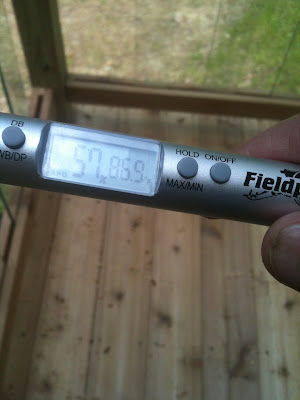Passive House Humidity when ERV/HRV/MHVR Ventilation at Equilibrium
 |
| High Temperature & Relative Humidity (Dew Point: 70F), Mid-Afternoon Late May 2013 |
In a recent article, I documented our passive house humidity profile during elevated levels of outdoor humidity. Once again we find ourselves with a period of very high outdoor humidity levels. Dew points are at their highest so far this season at 70F/22C with an outdoor temperature hovering around low 81F/27C and a relative humidity around 70%. Dew points are expected to rise even further as the week progresses. That's oppressively humid, indeed.
Fortunately for us, our earth tubes are providing temperatures ranging from 58.2F to 59.0 with relative humidity levels ranging from 89% to 88% respectively. This is reducing the dew points our ERVs are receiving down to 55F/13C-58F/14C, at zero operating cost!
What this means is that our earth tubes are doing the heavy lifting in actual dehumidification. This is a good thing too, as once again we are finding that our ERVs are at equilibrium as it pertains to humidity transfer. In other words, there is no enthalpy exchange going on between the exhaust and intake air and, therefore, no reduction of incoming humidity from the ERV to our supply registers.
As a consequence we are finding our indoor humidity (RH) levels to once again be tending towards 57-59% without active conditioning. Temperatures are just fine--peaking during the day to about 73F/23F.
To lower our indoor humidity, we must now rely (for short periods of time) on our mini-split(s) for active air conditioning. Amazingly though we are using only one unit (located in our family room) to do the job. Within one hour of operation the temperature and relative humidity level has dropped to 70.4F/21C and 54%.
Furthermore, the Fujitsu 9RLS2 is only consuming 2.46 amps at 240 volts (on cooling mode) and 1.1 amps at 240 volts (on dry mode) to do the work. That's fewer than 600 watts and 270 watts, respectively, at its peak consumption (remember it operates in a variable mode)! By my estimate this equates to an operating coefficient of performance (COP) of about 4.2 (very impressive for an air-to-air compressor!)--as good or better than a geothermal system when all components are taken into consideration.
Contrary to conventional wisdom (which suggest high flow settings to lower indoor humidity) we set our ERVs to their lowest standard operating levels which equate to approximately 17% of total air flow capacity. This enables the ERVs to perform maximum humidity and temperature transfers between exhaust and intake air flows, further improving their efficiency at reducing incoming humidity once the exhaust air reflects the lower indoor relative humidity levels that we attained with the mini split.
There appears to be so very little real-world data available online detailing passive house performance, I am providing the following data for those interested in examining passive house behavior during high outdoor temperatures and humidity levels.
Below is a snapshot of the Zehnder ERV/HRV/MVHRs operating characteristics:
Date: 05-22-13 at 08.31:
Outdoor Conditions: 73.4F/23C / 81% RH, Dew Point: 67F/13C
Comfoair 200 at 17% capacity:
Intake: 58.2F/15C / 89%, DP: 55F/13C
Exhaust: 60.4F/16C / 88%, DP: 56F/13C
Supply: 65.8F/19C / 71%, DP: 56F/13C
Return: 70.8F/22C / 60%, DP: 56F/13C
Novus 300 (Paul) at 17% capacity:
Intake: 59.0F/15C / 88%, DP: 55F/13C
Exhaust: 61.8F/17C / 82%, DP: 56F/13C
Supply: 67.3F/20C / 67%, DP: 56F/13C
Return: 70.5F/22C / 64%, DP: 58F/13C
Hi Bob, I am glad I stumbled upon your website. I have been reading all your post because I am planning on building a passive solar designed pole constructed home in Iowa that we plant to start building in April of 2015. I will be doing a lot of the same things you have done, like having most of my windows facing true south with over hangs to take advantage of the lower winter sun for heating our concrete floors. The home will have 6" walls and a white roof, and have radiant floor heating. I am trying to decided what form of cooling we will use and that is how I found your blog.
ReplyDeleteNow that you have used your Earth tubes and your Mini's to help cool your house, do you still thing they are worth the cost of installation? You can see my project on my farm blog http://milligansganderhillfarm.wordpress.com/2012/07/13/pole-barn-house/
Howdy!
DeleteYour project looks to be shaping up quite nicely. Wonderful land and I love your rustic interior wood look!
Have you determined your heating and cooling loads yet? Depending upon your requirements that could suggest the sizing of the system.
We had to overcome some real challenges and truthfully the EAT was installed later than it should have been, requiring us to re-dig around our foundation. We also have to be concerned with Radon levels in our area, and while we are fairing well on this front, it should be something that is considered before undertaking its construction.
My choice with installing them was in part due to my desire to add to the general knowledge of EAT utilization in Passivhaus construction. Something that we have really little data on. Jason Morosko (http://www.sustainablepath.us/) and I both wanted to contribute so we both made the plunge.
I would certainly consider installing them, but it is essential to design a system that won't present failures in the future.
You should hook up with Larry at http://www.earthairtubes.com/. He is out your way, which should make it very convenient for you.
Congratulations on your efforts!
Bob
Thanks Bob for getting back to me on this. I have looked over Larry's site before and I will consult with him if the earth tubes are what we decided to do. You haven't posted in awhile and I was wondering how your earth tubes have worked for you during this hot and humid summer?
ReplyDelete